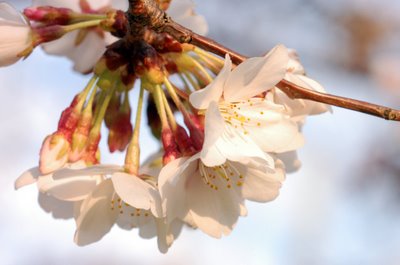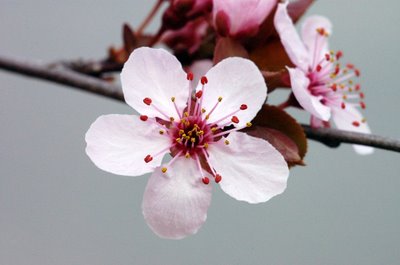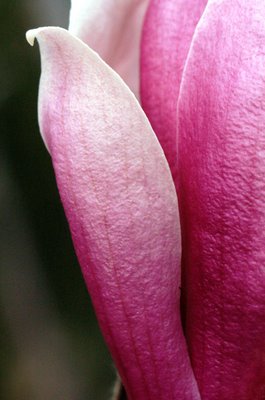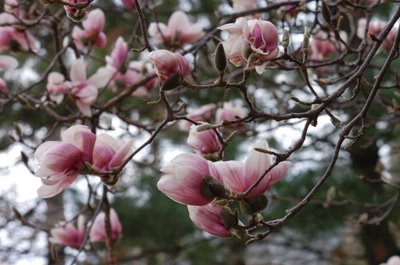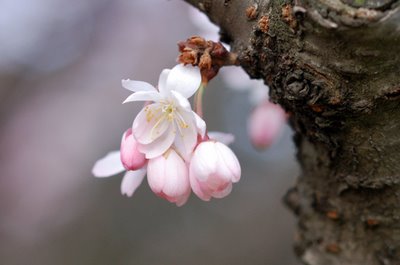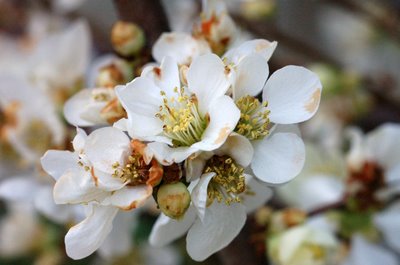Peach Trees
Thursday, March 30, 2006
 There are two peach trees at our community garden. They are in the public area of the park, so anybody can come and harvest the peaches.
There are two peach trees at our community garden. They are in the public area of the park, so anybody can come and harvest the peaches. I noticed two things while I was taking these photos. Some of the blossoms have a deep pink or fuchsia center, like this one (below).
 While others are light pink throughout, like this one.
While others are light pink throughout, like this one.Is one a male blossom and the other a female?
I also noticed that the buds have fuzz --
foreshadowing the peaches that will follow this summer.
I also noticed that the buds have fuzz --
foreshadowing the peaches that will follow this summer.


Fresh peaches. I can't wait!
Enjoying Spring

This evening I was taking photos of a cherry tree at the garden's edge when I caught this candid shot of friends encountering each other on the sidewalk. Both moms were out enjoying spring with their kids, the daffodils freshly picked. Do we have a young gardener-in-training? A future floral designer, perhaps?
Thirsty
Monday, March 27, 2006

The garden is desert dry; the soil is all crumbly. The worms, I think, must hate crawling through it. It feels scratchy. My seedlings are holding on for dear life, with a thirst they cannot quench.
This is turning out to be one of Washington, D.C.'s driest March's EVER, and I don't need a weather forecaster to tell me so. I can read it in the dirt.
This is an old photo taken during our February snow, but the faucet still sits dry. The water system at the community garden will not be turned on until mid-April, so until then, it's BYOB. Michael and I gathered soda and milk jugs from the recycling bin. We use them to make watering runs to our plot. It's a four-block walk, which isn't all that convenient to do with several gallons of water in tow. I carry what I can on some days and Michael drives on others, but we can't get to it every day. We need rain desperately.
The forecast is calling for a meager one tenth to one quarter of an inch of rain tomorrow evening. I'll take it! Every last bit!
But I am not recycling those milk jugs just yet.
Plotting a revolution... one tomato at a time
Friday, March 24, 2006
Roger at Kitchen Gardens International maps out a subversive plot to convince his neighbors to convert part of their yards to vegetable gardens. I like his idea!Michael and I have often said that, when we get a house, we don't want to have much of a lawn. Why would we want to spend a chunk of our weekend mowing grass (only to mow it again a week later) when we could instead have the fun and pleasure of growing something delicious to eat?
Step on it!
Wednesday, March 22, 2006

Michael bought these two pots of Goldenmoss Stonecrop (Sedum acre), which we are going to plant along the stone walkway in the front area of our garden. He was attracted to these plants in particular because of their fun brand name: Stepables. (Ah, the marketing got to him!)
Goldenmoss is said to endure not only foot traffic but also dry conditions. That is a good thing since, at the rate we are going -- with our rainless March -- we might not be successful with much else. It is supposed to get tiny yellow flowers in June and July and then the foliage will take on a reddish color during the cold months.
A few interesting tidbits about this plant: The "acre" in its name means "sharp." This site notes that the plant has a bitter taste. In small quantities, it can be used as a survival food, but too much can cause stomach upset. Cedar Nursery in the U.K. says it was "used as a purgative since Roman times or before and was actively cultivated by medieval monks, consequently it is often found on the sites of ancient monasteries."
Needless to say, we are not going to eat it. Michael, I think, is merely looking forward to the maintenance procedure: stepping on it!

Old Man Winter Eats Broccoli
Monday, March 20, 2006
A sad sight at the garden on Saturday: The leaves of the two broccoli plants I set out a week ago were found limp, withered, and lifeless. They did not survive Old Man Winter's near-to-last gasp. And tomorrow, adding insult to injury, we are supposed to get snow showers.Knowing that broccoli is a frost-tolerant plant (and given that it was in the 70s last weekend), I thought we were in the clear. But not so. While I was thinking that our last average frost date is April 15th, I did not think about the last average freeze date. They are not one in the same, as Michael and I would learn from the pros at our favorite garden center. All the seed packets say to plant things in relation to the last spring frost date, so I began accordingly with our planting schedule, perhaps a bit too eagerly.
Lesson learned: Broccoli likes frost, but not of the heavy-duty variety.
Not to worry, though. Those two sacrificial broccoli plants have paved a safer path for the survival of three additional seedlings that remain huddled safely under the grow lights.
In other news, Michael planted more seeds (indoors!) yesterday. He's growing more tomatoes, poblano and jalapeno peppers, and four varieties of eggplant. He makes a wonderful eggplant frittata from The Silver Spoon cookbook. It has thin slices of eggplant nestled among layers of red bell peppers, scrambled eggs, parsley, and Parmesan and fontina cheeses. Mmmm.... (Broccoli? Who needs broccoli?)
Peas were planted...
Friday, March 17, 2006
Today at the garden:1. Spinach and peas were planted.
2. Bok choy and radishes sprouted.
3. Baby romaine lettuces began getting their mature reddish tint.
4. I discovered that rhubarb chard gets big tuber roots. (Who knew?) So I dug them back in.
5. A robin scurried through the plot looking for worms.
6. Fellow gardeners built beds, hauled mulch, and turned soil.
7. Mockingbirds shivered as they sang their little hearts out.
Shamrocks
Tuesday, March 14, 2006
 With St. Patrick's Day coming up later this week, I decided to learn something about shamrocks. According to Dr. Charles Nelson, a botanist and native of Northern Ireland, "Shamrock is the English form of the Irish word seamrog, which literally translated means 'little clover' or 'young clover'." Trifolium dubium is the most common of four types of clover that are referred to as Irish shamrocks. They are in the pea family.
With St. Patrick's Day coming up later this week, I decided to learn something about shamrocks. According to Dr. Charles Nelson, a botanist and native of Northern Ireland, "Shamrock is the English form of the Irish word seamrog, which literally translated means 'little clover' or 'young clover'." Trifolium dubium is the most common of four types of clover that are referred to as Irish shamrocks. They are in the pea family.The Cobb County Extension Service notes that Trifolium dubium is extremely difficult to grow indoors. The Oxalis plant, like mine in the photo above, is usually what garden centers and grocery stores sell as "shamrocks" instead.
Oxalis is one of my favorite house plants. It's easy to care for and likes indirect light (which is the only option I have in the apartment). What I really like about oxalis is the way it closes down its leaves at night, as if it's saying, "I'm done for the day."
 Indiana University, on its Plants in Motion website, has a video that shows how the leaves fold down. It is fun to explore some of the other videos as well. Play the one called morning glory twining. It's kind of creepy the way the vine swings around until it can grab onto something to strangle! I didn't know they moved around like that. Interesting.
Indiana University, on its Plants in Motion website, has a video that shows how the leaves fold down. It is fun to explore some of the other videos as well. Play the one called morning glory twining. It's kind of creepy the way the vine swings around until it can grab onto something to strangle! I didn't know they moved around like that. Interesting.
Battling the Wire Grass
Sunday, March 12, 2006

It's Sunday evening and the stiffness and soreness is beginning to set in from all the digging I did today. It was a great workout though.
With weather in the 70s, Michael and I were able to accomplish a lot in the garden these past two days. He cleared out almost all of the wire grass that had accumulated along the fence between our plots and the two neighboring plots to the east of us. It was a major project that involved taking down the fence, digging a deep trench, removing the pesky wire grass, laying down newspaper, filling the trench with several loads of wood chips, and replacing the fence. Whew! I get tired just writing about it.
I dug up the bed where we are going to expand the herb garden. Wire grass from the neighboring plot had been invading from underneath, and the only way to get rid of it is to dig it up entirely.
I also set out two of my broccoli plants (seen in the foreground of the photo). I set out one of them on Friday night so it could get acclimated, and would you believe, the next day it already had whiteflies on it! A bit discouraging to say the least. I think it's because we didn't have a harsh winter. All the bugs are still around -- and now they are hungry.
So today we bought some organic, biodegradable, insecticidal soap. (Our community garden is all organic, so we can't use chemical killers, which is a good thing.) This concoction has garlic and peppermint in it. We'll see if it works. If it doesn't, I think I will just skip the broccoli this year and plant something else. It is too early in the game to get discouraged.
Growing Garlic
Wednesday, March 08, 2006
 Did I ever think I would be growing my own garlic in Washington, D.C.? No. Never. But I do.
Did I ever think I would be growing my own garlic in Washington, D.C.? No. Never. But I do.This is the last head of garlic from our first-ever crop. We planted two heads each of two different varieties: German Extra Hardy and Siberian. We ordered the bulbs from Seed Savers Exchange, a company I like to support because it's making an effort to save heirloom seeds and plants.
It was truly an enjoyable process to grow garlic. Before having a garden, I never thought about where it grows, when it grows, or how it grows. And to be honest, I didn't care. I didn't once think about it. Garlic is so easy to find in any grocery store, anywhere, at any time of year. And it's cheap. So why bother?
What was so rewarding is that I learned the answers to these questions. Yes, we can grow garlic in Washington, D.C. It goes into the ground like a fall flower bulb. (We put it in around Columbus Day in October). It likes a rich, well-aerated soil and a good layer of mulch. It grows curly extensions called scapes, which are good in stir-frys. We harvest the heads in June and hang them in the kitchen to dry and develop their flavor.
Garlic is the basis of so many things we cook. Garlic grown by our own hand adds something very special to each recipe. I take extra care now when I peel the cloves. I think about how it grew. I remember how eagerly I awaited the harvest. How it felt to pull each treasure from the cool, moist ground -- pulling away the mud to reveal their perfect, papery-white skins. The smell in the kitchen. The drop of a gardening journey in every dish.
First Dig
Monday, March 06, 2006

Yesterday afternoon, Michael and I got out to the garden and started turning the soil. How great it felt to get out there and DIG! He added Bumper Crop to the bed where he is going to plant the tomatoes. I pulled weeds and sowed a row of bok choy and radish seeds. I was probably jumping the gun, but I just couldn't help myself. I had to plant something!
I harvested the Brussels sprouts. The top photo is a close-up view of what they looked like on the stem. This photo provides a better perspective on the actual size of our, um..."crop".
 Pretty puny, huh?
Pretty puny, huh? Well, they are Brussels sprouts nonetheless. And I was happy to have grown even these few. I am going to cook them tonight. All two forkfuls. Michael bought a few more from the store, as a supplement.
My friend from China
Friday, March 03, 2006

These are the carrots I pulled from the garden today -- the final bunch from last fall's crop. I am going to use them in a chicken broth I am making.
On my walk through the garden today, I was not at all surprised to find Wenhua. She is a woman from rural China who joined the community garden last year. She is often there in the morning or evening, rain or shine.
When she first came to the garden, she did not know that each plot was assigned to a specific person. She would go in and start working on any plot that needed tending. Since there was a long waiting list for plot assignments, one of the gardeners offered to share a space with her. And by the end of the summer, she was assigned a plot of her own.
Wenhua hardly spoke any English when she joined us. She could say "flower", "cucumber," and "How are you?" We used a lot of hand motions, nods, and smiles.
When I saw her today, I found out she could say "a,b,c,d" and "1,2,3,4..." She also knows "tomato" and "beans" now, but for the most part, we still can't communicate easily.
She pointed over to where my plot is and said "garden?" I said, "Yes, I will have my garden there again this year." She then embraced me in a giant and enthusiastic hug. It was as if we were saying to each other, "It's great to see you again! Welcome to the new gardening year."
That moment made my day.
Here we are, two women from opposite sides of the planet, speaking two very different languages, and hardly able to communicate in words. But we are drawn together by this place and our mutual enjoyment of planting this little piece of Earth.
The tourists are coming!
Thursday, March 02, 2006
One million people are expected to visit Washington, D.C., to see the famous cherry trees. This year's Cherry Blossom Festival is scheduled for March 25- April 9.Tim Rucci's photo album offers a nice preview, sans all the tourists. And the Festival Web site keeps tabs on the forecast for peak bloom time.
The trees around the Tidal Basin are definitely worth seeing at least once (or twice, or three times), although, as a Washingtonian for eleven years, I now prefer to enjoy a quieter and more solitary viewing of the cherry trees that are scattered throughout various D.C. neighborhoods. I am fortunate to live in a place that has the most beautiful springtime imaginable.
Early Bloomers
Wednesday, March 01, 2006
"The flowers of late winter and early spring occupy places in our hearts well out of proportion to their size." ~ Gertrude S. WisterYesterday, I saw the season's first daffodils. Snowdrops and crocus are bringing life and color to people's yards.
I found this quote to be so true. I will admire the tulips and dogwoods that arrive later, but there is an unparalleled, spirit-lifing joy that comes with first sight of the tiniest and earliest blooms.






